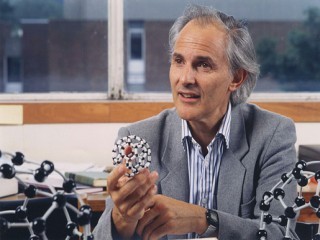
Sir Harold W. Kroto biography
Date of birth : 1939-10-07
Date of death : -
Birthplace : Wisbech, Cambridgeshire, England
Nationality : British
Category : Science and Technology
Last modified : 2011-09-20
Credited as : chemist, co-discoverer C60, Nobel Prize
0 votes so far
In a series of experiments carried out in September 1985, the two men, along with Smalley's associate at Rice, Robert Curl, generated clusters of carbon atoms by vaporizing graphite in an atmosphere of helium. Some of the spectra they obtained from the vaporization corresponded to previously unknown forms of carbon containing even numbers of carbon atoms ranging from 40 to more than 100. Most of the new carbon molecules had a structure of C60. The researchers recognized that this molecule's atoms are bonded together in a highly symmetrical hollow structure that resembles a sphere or ball. C60 is a polygon with 60 vertices and 32 faces, 12 of which are pentagons and 20 of which are hexagons-the same geometry as that of a soccer ball.
In the 1985 paper describing their work, the discoverers chose the whimsical name buckminsterfullerene for C60, after the American architect R. Buckminster Fuller, whose geodesic dome designs have a structure similar to that molecule. The discovery of the unique structure of fullerenes, or buckyballs, as this class of carbon compounds came to be known, opened up an entirely new branch of chemistry.
Awards and honors:
Bell Laboratories (1966-67)
National Research Council of Canada (1964-66)
APS International Prize for New Materials Research 1992 (with Robert F. Curl and R. E. Smalley)
Italgas Prize for Innovation in Chemistry 1992
RSC Longstaff Prize 1993
Agilent Technologies Europhysics Prize 1994
Knight of the British Empire 1996
Nobel Prize for Chemistry 1996 (with Robert F. Curl, Jr. and Richard E. Smalley)
Manchester John Dalton Medal 1998
Erasmus Medal of Academia Europaea 2000
Faraday Prize 2001
Copley Medal 2004
Academia Europaea 1993
Finnish Academy of Science and Arts Foreign Member
Korean Academy of Science and Technology Foreign Member
Mexican Academy of Sciences Foreign Member
National Academy of Sciences Foreign Associate
Royal Microscopical Society
Royal Society 1990
Royal Society of Chemistry President (2002-04)
Royal Society of Edinburgh 1998
World Technology Network
















